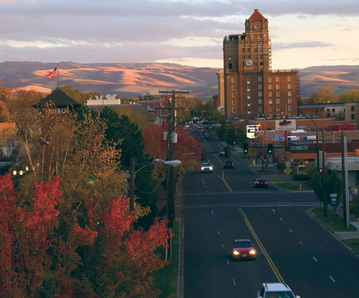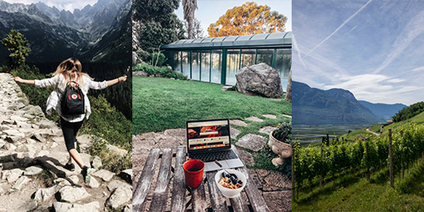|
This article was authored by PNWER Innovation co-chair, Nirav Desai, CEO of Moonbeam Exchange, and was originally published as op-ed in Medium. You can fit more than 40 Bends or 120 Walla Wallas in metro Seattle, and still have room for a few more Starbucks. Named after the Farewell Bend in the Deschutes River, tech workers and executives have been making the delighted acquaintance of outdoor sports and craft-beer utopia Bend for several years. Nestled between the Cascade Mountains and the high desert, Bend is a summer and winter sports destination. It is also home to some of the best-known craft breweries in the region, including Deschutes, 10 Barrel, and Crux. The quality of life in Bend helps explain why its remote workforce also grew 23% between 2013 and 2015. (Source: Bend Bulletin) Walla Walla began its life known as Nez Perce, so named for the fort built there to establish trade relations with the local indigenous group of that name. Since then, the eponymous county seat (which changed its name when the fort did, to the indigenous phrase “place of many waters”) was reborn again and again, from a missionary college to a fur trading hub for Hudson Bay, to an Army fort again, to a Gold Rush town, and for about a century after, an agricultural center of south-eastern Washington. If you drive in, your first sights of the city limits will show you those agricultural foundations remain intact, but at least as often as wheat or Walla Walla sweet onions (the state’s official veggie), you’ll see sprawling, scenic wineries, whose Merlots, Cabs, and Syrahs flourish in the region’s Mediterranean climate. With these wineries come the attendant businesses: high-end restaurants, luxury hotels, and festivals.  Walla Walla at sunset (Photo courtesy Visit Walla Walla) Walla Walla at sunset (Photo courtesy Visit Walla Walla) Look closely, and you’ll see that none of this rural luxe is bolted ad hoc onto the gentrified quarter of an otherwise sullen community of less-fortunate townies. The vineyards, craft breweries (wheat remains an important staple), and restaurants harness local skill sets that were already there, honed by over a century. The elegant Marcus Whitman hotel, boasting tech-enabled conference centers and plush meeting rooms, is a rehabilitated local landmark nearly a century old. This booming local hospitality and service industry in both towns wouldn’t exist without standing demand. Between four to six hours from both Portland and Seattle, they are a driveable weekend destination, but what’s made Bend and Walla Walla Cinderella stories rather than a boom town flash in the pan is their ability to strategically innovate and attract talent. They have found a way to attract a unique brand of tech commuters: tech elites empowered by the ongoing remote-work revolution to trade 10th floor office window views of 1st Ave for home offices close to hiking and mountain biking destinations. None of this was an accident. Rather, it is a testament to smart regional economic development. The success of certain north-western small and medium cities like Walla Walla and Bend are creating a model for sustainable small towns that has fertile ground across the region and the nation. The COVID-19 pandemic lit a fire under the telework movement- 77% of human resources executives expect the trend toward remote work to continue, even one year after COVID-19 substantially subsides. (Source: Conference Board 2020 survey) The sprouts of economic recovery before the large-scale reopening of the country has even begun demonstrates, in part, that productive remote work has found its footing: companies able to maintain a remote workforce have found overwhelmingly that productivity has been maintained or increased, coupled with the obvious massive savings in costs of facilities, travel, and centralized infrastructure. When you can work anywhere, sooner or later you’ll probably ask yourself, “do I have to live in a dense technology center just to do my job?” Now that it’s been proven possible, demand for alternatives to dense urban lifestyles for skilled technology sector workers has hatched, and it’s only going to grow. Communities just need to show up. Not A Bedroom Community — A Fully-Integrated Local Economy Walla Walla’s was powered by calculated moves made by the local government. Harnessing the skills and assets of the existing population and localities included pivoting- not replacing- to adjacent value creation. Their community college invested heavily in leveraging a long-standing, quality agricultural sciences program to quickly develop local viniculture talent, creating a standing workforce ready to put existing farmland and infrastructure to work. Surrounding commercial zones (extant or created) transitioned to upscale dining and retail collateral to the wine boom; demand for hospitality followed naturally. Bend has been marketing its quality of life for remote workers for years citing high profile profiles of commuting and remote working tech executives. According to the U.S. Census in 2015, 9.3% of Bend workers are remote workers. (Source: Bend Bulletin)  Mount Bachelor outside of Bend, OR Mount Bachelor outside of Bend, OR The planned revitalization and growth into a lifestyle city holds balance at its core. This isn’t about building an amusement park and resort in the middle of a desert; existing, localized value, skills, and labor are the starting point. When Amazon built its Seattle headquarters, for example, a condition of their agreement with the city was that the campus would not include a cafeteria and similar support facilities- employees would need to engage the surrounding communities for places to eat, gather, do laundry, get healthcare, and so on. For a second or third-tier city to plan its evolution into a lifestyle city, this sort of social contract is even more important, because there won’t be facilities popping up downtown, built by the employers of your incoming tech elite. You’ll need to grow your own- and the potential upside to your local population is far, far greater than becoming a company or campus town. Where Can Cities Start? While every city heading down this evolutionary path brings unique value to the table, there are fundamentals every planning committee should begin with. A solid, complete coverage of high-quality broadband is an absolute necessity, and the very first thing any municipality should prepare if they want to benefit from remote working trends. For many rural communities who aren’t already in this position, it’s the most daunting- but there’s a wealth of resources for clearing this hurdle. The Rural Economic Development Innovation (REDI) Initiative (for communities of 50,000 or less), Telecommunications Infrastructure loans and loan guarantees, and Strategic Economic And Community Development funding are all offered by the US Department of Agriculture for rural communities taking steps to develop infrastructure- and there are numerous grants within, and beyond, these programs. Consider enlisting the services of an agency that can help you gather and analyse data on value in your region- what do you have? what do you want to attract? How to partner with other innovators? and the expertise to benefit from other investments and compete globally.[2] The post-COVID business landscape holds the seeds of a renaissance in the relationship between work and location, and unprecedented opportunity exists for communities able to offer unique, distinctive character beyond the urban landscape. The development of lifestyle cities allow small towns the opportunity to create sustainable growth, retain their character, and honor their history while building a future. Takeaways — The acceleration of transition to full-time remote work has created an unprecedented opportunity for small cities in the Northwest to create vital, sustainable local economies catering to technology workers now able to sustain well-paying work outside of dense urban tech centers. — This opportunity allows localities to enjoy the tax revenue of high-income — residents without the accompanying disruption to economic balance, or tax breaks to companies associated with the more traditional introduction of business facilities (factories, offices, etc.). — The impetus is on the locality to provide the essential building blocks of a lifestyle city attractive to this influx: broadband internet and attractive activities unique to the community (restaurants, culture, local specialties) are a minimum. — Communities will need to leverage their intrinsic value- natural beauty, local attractions, and existing infrastructure that can be upgraded or pivoted to create a balance of quality living accessible to both existing populations and incoming talent. — Every move should be calculated to capture value, invite sustainable levels of growth, and invest in core capabilities; this begins with an intensive data analysis of local and regional factors.
0 Comments
Your comment will be posted after it is approved.
Leave a Reply. |
Archives
August 2023
Topics
All
|
|
World Trade Center West
2200 Alaskan Way, Suite 460 Seattle, WA 98121 |
|

